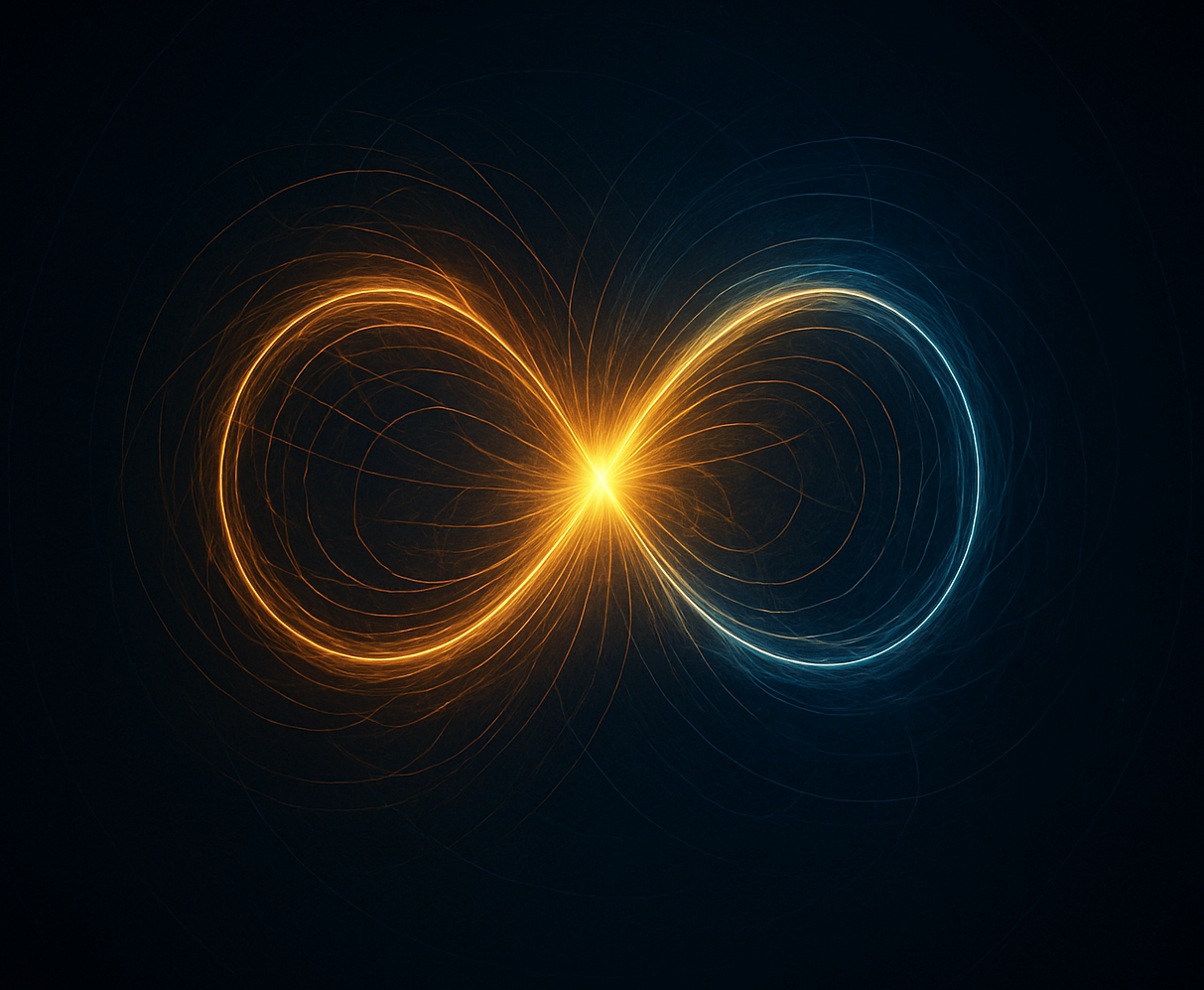Chapter 06
The Uncertainty Principle
So much of modern physics is permeated by this principle that without it, quantum mechanics and science in general would not be the same. It acknowledges that we can never know precisely or measure simultaneously, each of the physical properties that combine as a product to form the minimum of angular momentum. That is: mass, velocity (speed of light) and radius (reduced Compton wavelength). This is because the smallest of all things (a particle) always has one whole cycle or quantum vibration of an E-M field in it, which gets more compacted when new energy is added. Energy makes h spin faster. More energy means more mass which means a denser, tighter curl with a higher frequency. This makes complete sense according to classical physics and Maxwell. What does quantum mechanics say about this for it maintains particles have no structure and so there is nothing to spin?
The only way light can spin faster is to spin shorter. But still, angular momentum is always h for the complete roton, whereas each loop consists of one-half h at a time. This makes some surprising things possible in the subatomic world, when they combine to form h or a quantum wave. It is the product that matters, not the individual components separately. This is critical to our theory of SED and the atom. In fact, it could also be said that because of the structure of the roton with its two loops, this principle is formulated the way it is(1). In short, it is why the factor of a half of h is included
The uncertainty principle comes about because we can never contemplate separating a roton into anything less than either one of its two loops. It is meaningless to even consider a fraction of a loop and less than the half h that it consists of. Whether we are thinking of momentum-distance, energy-time or h itself, there is always a minimum of this value that has any physical reality. We can never measure anything less. This is why we talk of a kind of fuzziness or uncertainty in the quantum world. It has nothing to do with accuracy. It is just what reality is.
A highly significant corollary of this principle is that it enables nucleons to form as we will soon see in the section on the atom. Nucleons reside in the nucleus of an atom and provide nearly all of its mass. There are two types: protons with a single positive charge and neutrons with none. Both have almost the same mass although the neutron has slightly more. The other atomic particle is the electron, a lepton. All three are fermions and portray mass. How they form and interact will be discussed in more detail in our sections on the electron and the atom.
Physics has always classified nucleons and leptons differently without providing a clear and concise reason for this, other than saying leptons do not participate in the so-called strong force. Now this theory, linked with the uncertainty principle, shows how an alternate structure for nucleons allows them to have two states available simultaneously, unlike leptons which have only one. This enables them to combine and form the nucleus of an atom.
Like virtual particles that exploit the uncertainty principle to borrow energy and exist for a very short time, or electrons that can tunnel through normally impassable barriers, nucleons utilise this principle to alter their soliton on average every second cycle. They do this independently and build a structure based on probabilities, with properties unavailable to leptons. Properties like two variants of the basic form; one having charge and the other not. Occasionally one type of nucleon can transform into another. However, for these transformations, external particles such as leptons, neutrinos and photons are always involved. There is no need to reference the weak force, whatever that means. Later we will review how these particles are first created to form all the matter we observe in the universe.
For now, we return to the origin and consequences of the uncertainty principle. As we have said, it is intimately connected with Planck’s constant and the formation of matter due to the structure of the roton. Nothing can enter the space that the roton occupies and yet it has no surface. It is merely a tiny path that light follows endlessly, over and over as its fields vibrate and convert into their opposite. But these rotons always contain one unit of Planck’s constant of angular momentum and this can occasionally portray as a kind of momentum-distance or energy-time relationship in our larger world depending on the circumstances, for both these things have the same units as h and are made from h. Other complementary pairs like these exist in all sorts of ways in quantum mechanics and there is a mathematical term called non-commuting associated with them. However, we need not go into these details at this stage, only how the meaning of the uncertainty principle arises and how it influences science in many ways.
When we use the term uncertainty in this principle, we mean that it is fundamentally impossible to know or measure exactly and simultaneously each component in the above relationships. Even though h is miniscule, the consequence is profound in the subatomic realm. For instance, if we wish to know how long a certain interaction takes to change an electron’s energy level from A to B, and we know A and B very precisely, then this duration must have a large uncertainty associated with it. This has nothing to do with the accuracy of our clocks or our measurement procedures. If we could somehow accurately measure the duration first, then we would find that the two energy levels are not as certain as before. An identical situation applies when trying to measure an object’s position and momentum, although these effects are only really observable for subatomic particles.
Once again, the reason can be traced back to structure, and how the roton works. We cannot measure anything in this world without incorporating fundamental particles of matter. Other than in our imagination, no object nor measuring device can exist without elementary particles and it is the structure of these particles and their behaviour that is critical to understanding the uncertainty principle.
Mathematically, this principle can be written as: ΔPΔx ≥ ћ/2 or ΔEΔt ≥ ћ/2, where P stands for momentum and x is position, and likewise E is for energy, and t is time. The delta symbol, Δ means the range or spread, and here refers to the minimum uncertainty that can exist, and in this case, this is always greater than or equal to ћ/2.
Note that we always have a product of two measurables in these expressions. The only thing that exists alone is ћ/2 and this is always constant. As a consequence, a combination like this of two things having a fixed value in their product, allows for one to be large and the other small and vice-versa, as well as all values in between. This accounts for some of the apparently strange phenomena we sometimes observe in quantum mechanics like tunnelling electrons and virtual particles that can momentarily pop into and out of existence in an apparent vacuum where nothing seemed to exist.
As we have often said, the roton can never be divided nor can its structure ever be penetrated by another object. This is absolute. So, there is no way that we could even associate a meaning or give physical reality to something less than the two loops and what a roton is.
On these grounds, consider trying to exactly measure the space-time between two rotons or fundamental particles. Of course this is impossible, because of the size and dynamics of both, let alone the concept of what measuring device we could use. However, the essence of this idea and its very absurdity may help in grasping why the uncertainty principle exists, as well as its mathematical formulation.
To go from one particle to another and trace their separation means starting at some point on one and finishing at another point on the other. Do such points exist? According to SED, only the two loops have physical reality or meaning in a roton. Smaller than this is not a measurable thing. It is not possible to even conceive of a more precise measurement because there is no smaller quantity or value less than this.
That is why the minimum uncertainty in everything must always be larger than a half unit of Planck’s constant.
(1) That is: ΔPΔx ≥ ћ/2 or equivalently, ΔEΔt ≥ ћ/2, where P is momentum, E is energy, x is position and t is time.
The Origin of Everything
(Online Edition)
































